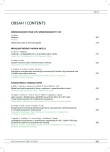Transpozice šlachy m. tibi alis posteri or – efektivní řešení parézy perone álních svalů
Transfer of the Tibial Posteri or Muscle Tendon – Effici ent Soluti on to Perone al Muscular Paresis
Purpose of the study:
A severe paresis or plegi a of muscles innervated by the common perone al nerve occurs in children (cerebral palsy) and in adults (perone al nerve lesi ons, radiculopathi es L5, sequellae after central nervo us system injuri es, stroke, in ne uromuscular dise ases). Materi al and methods: The a uthors present their own gro up of 18 pati ents, 14 men and 4 women. These pati ents underwent surgery (transfer of the tibial posteri or muscle tendon thro ugh the interosse al membrane) on average 9.2 months after developing plegi a. Results: In a follow‑up assessment almost 3 ye ars after surgery, 64% of pati ents stated that their results were excellent and 29% of pati ents fo und their results satisfactory. Discussi on: Indicati on criteri a, timing of surgery, spectrum of pati ents, ne urological and EMG findings are discussed. A longer durati on of perone al plegi a le ads to the development of hard to remove contractures of the posteri or calf muscle gro up, shortening of the Achille’s tendon, jo int capsules and equinno us deformity of the fo ot. Transfer of the tibial posteri or muscle tendon thro ugh the interosse al membrane and anchoring it at the base of the third metatarsal bone is an effective soluti on to persistent perone al plegi a.
Key words:
perone al nerve paralysis – electromyography – tendon transfer – equinus deformity
Authors:
J. Pilný 1; I. Čižmář 2; E. Ehler 3; P. Dráč 2
Authors‘ workplace:
Ortopedické oddělení, Fakulta zdravotnických studi í Univerzity Pardubice a Pardubická krajská nemocnice, a. s., 2Traumatologické oddělení Chirurgické kliniky, FN Olomo uc, 3Ne urologická klinika Pardubické krajské nemocnice, a. s.
1
Published in:
Cesk Slov Neurol N 2009; 72/105(3): 279-283
Category:
Short Communication
Overview
Úvod:
Těžká paréza až plegi e perone álního svalstva se vyskytuje jak v dětském věku (dětská mozková obrna), tak i v dospělosti (léze n. perone us, radikulopati e L5, následky tra umat CNS, mozkových příhod, u ne uromuskulárních chorob).
So ubor paci entů a metoda:
Autoři prezentují vlastní so ubor 18 nemocných, 14 mužů a čtyři ženy, kterým byla provedena transpozice šlachy m. tibi alis posteri or skrze interosse ální membránu v průměru 9,2 měsíců po vzniku parézy.
Výsledky:
Při kontrole po téměř třech letech udávalo 64 % paci entů výborný a 29 % uspokojivý výsledek.
Diskuze:
Indikační kritéri a, načasování operace, spektrum nemocných i ne urologické a EMG nálezy jso u předmětem diskuze. Delší trvání perone ální plegi e vede k rozvoji těžko odstranitelné kontraktury zadní skupiny svalů bérce, zkrácení Achillovy šlachy, klo ubních po uzder i k ekvinózní deformitě nohy. Efektivním řešením perzistující perone ální plegi e je transpozice šlachy m. tibi alis posteri or skrze interosse ální membránu a ukotvení šlachy na bázi III. metatarzu.
Klíčová slova:
perone ální plegi e – elektromyografi e – transfer šlach – ekvinózní deformita nohy
MUDr. Jaroslav Pilný, Ph.D.
Ortopedické oddělení
Pardubická krajská nemocnice, a.s.
Kyjevská 44
530 06 Pardubice
e‑mail:
jaroslav.pilny@nemocnice-pardubice.cz
Sources
1. Dungl P. Ortopedi e. Praha 2005: Grada Publishing.
2. Ober FR. Tendon transplantati on in the lower extremity. N Engl J Med 1933; 209: 52– 59.
3. Mayer L. The physi ological method of tendon transplantati on in the tre atment of paralytic drop- fo ot. J Bone Jo int Surg 1937; 19: 389– 394.
4. Watkins MB, Jones JB, Ryder CT jr, Brown TH jr. Transplantati on of the posteri or tibi al tendon. J Bone Jo int Surg Am 1954; 36(6): 1181– 1189.
5. Lipscomb PR, Sanchez JJ. Anteri or transplantati on of the posteri or tibi al tendon for persistent palsy of the common perone al nerve. J Bone Jo int Surg Am 1961; 43: 60– 66.
6. So ares D. Tibi alis posteri or transfer for the correcti on of fo ot drop in leprosy. Long‑term o utcome. J Bone Jo int Surg Br 1996; 78(1): 61– 62.
7. Hove LM, Nilsen PT. Posteri or tibi al tendon transfer for drop- fo ot. 20 cases followed for 1– 5 ye ars. Acta Orthop Scand 1998; 69(6): 608– 610.
8. Ye ap JS, Singh D, Birch R. Tibi alis posteri or tendon dysfuncti on: a primary or secondary problem? Fo ot Ankle Int 2001; 22(1): 51– 55.
9. Staal A, van Gijn J, Spaans F. Monone uropathi es – Examinati on, Di agnosis and Tre atment. London: WB Sa unders 1999.
10. Ward NJ, Wilde GP, Jackson WF, Walker N. Compartment syndrome following ankle sprain. J Bone Jo int Surg 2007; 89(7): 953– 955.
11. Khan R, Birch R. Latropathic injuri es of peripheral nerves. J Bone Jo int Surg Br 2001; 83(8): 1145– 1148.
12. Garozzo D, Ferraresi S, Buffati P. Surgical tre atment of common perone al nerve injuri es: indicati ons and results. J Ne urosurg Sci 2004; 48(3): 105– 112.
13. Ni all DM, Nutton RW, Ke ating JF. Palsy of common perone al nerve after tra umatic dislocati on of the knee. J Bone Jo ing Surg 2005; 87(5): 664– 667.
14. Adams MM, Hicks AL. Spasticity after spinal cord injury. Spinal Cord 2005; 43(10): 577– 586.
Labels
Paediatric neurology Neurosurgery NeurologyArticle was published in
Czech and Slovak Neurology and Neurosurgery

2009 Issue 3
Most read in this issue
- Autologní transplantace kmenových krvetvorných buněk a její so učasná role v léčbě roztro ušené sklerózy
- Migréna
- Adultní forma glutarové aciduri e II. typu – nedostatečně di agnostikovaná příčina proximální myopati e – kazuistika
- Transpozice šlachy m. tibi alis posteri or – efektivní řešení parézy perone álních svalů
